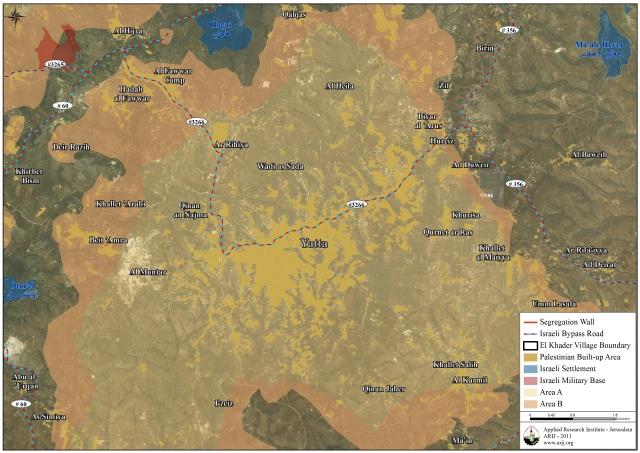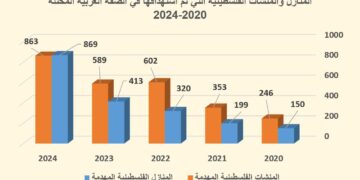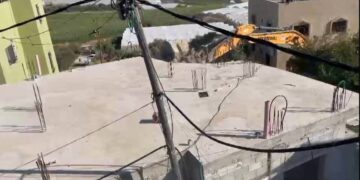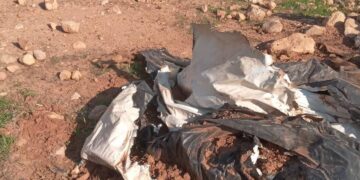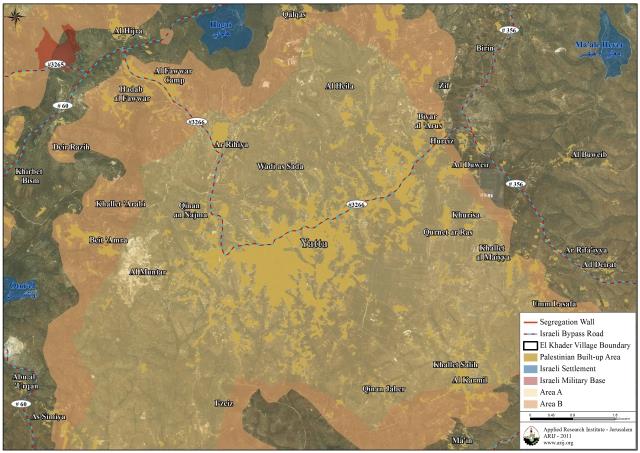On May 5, 2011, the Israeli Army bulldozers protected by the Israeli Army Forces stormed Khirbet Em Nayyer east of Yatta town in Hebron Governorate, and demolished 8 residential tents, 4 barracks and an animal sheds and uprooted more than 600 olive trees owned by Al Jabbour family under the pretext of lacking building permits. The owners of the demolished structures are: Issa Hassan Al-Jabbour, Majid Issa Hassan Al-Jabbour, Issa Mohammad Ahmad Al- Jabbour, Omar Mohammad Al-Jabbour, Khadra Mohammad Ahmad Hoshieh, Taleb Mohammad Esmaeil Al-Jabbour, Khalil Mousa Hussein Al-Jabbour, Ibrahim Mousa Hussein Al-Jabbour, Mahmud Ahmad Al-Jabbour, Mohammad Hussein Al-Jabbour, Khalil Mohammad Khalil Al-Jabbour, and Rebhi Khalil Ahmad Al-Jabbour.
During the demolition the Israeli Occupation Army arrested and injured several local citizens of them were know: Fouad Al Nawaja’a (24 years old), and Issa Hussein Mohammad Al -Jabbour (65 years old). Moreover, the Israeli occupation Army campaign against Khirbet Em Nayyer continued to the following day when in the early morning, the Israeli Army Forces razed Khirbet Em Nayyer and forcibly evacuated the families from their tents that they installed instead of their demolished ones.
Eradicated for the Third Time
It is worth to point out that this was not the first time that Khirbet Em Nayyer was targeted by the Israeli Occupation Army where it had been demolished two times before. The first demolition was in February 2011, when the Israeli Army bulldozers demolished structures, barrackses, and tents in addition to two water wells and uprooted dozens of olive trees in Khirbet Em Nayyer under the pretext of lacking building permits.
Later on and in March 2011, the Israeli Army bulldozers and without a prior notification demolished Khirbet Em Nayyer for the second time and destroyed all of the structures and tents, where these tents were donated by the International Committee of the Red Cross (ICRC) and by the Palestinian Prime Minister Office.
Mr. Zahran Abu Qbeita, the head of Yatta town council indicated that the owners of the targeted lands have the certificates and registration documents (Turkish Tabo) which prove their ownership of their lands. Mr. Abu Qbeita also added that the Israeli Army Forces are targeting Khirbet Em Nayyer where it became a legitimate target for the herds of the Illegal Israeli settlers of the adjacent Israeli settlement of Susiya [1], who usually attack the local residents and their tents in an attempt to displace them from their own lands in order to expand the Illegal settlement.
Yatta is a Palestinian town located 9 kilometers south of the city of Hebron at the southern parts of the West Bank. It is bordered by Ar Rihiyya village and Al Fawar Refugee Camp and Wadi As-Sada from the north, As Samu’ village from the south, Beit ‘Amra village from the west, Zif and Khallet Al Maiyya communities from the east. The total population of Yatta town is 54,608 (PCBS 2010), where the total area is 270,000 dunums, of which, 14,000 dunums constitute the town’s built-up area. See the map below:
Map of Yatta town
The Geopolitical Divisions of Yatta town:
According to the Oslo IIInterim Agreement of 1995 which was signed between Israel and the PLO (Palestinian Liberation Organization) on September 24, 1995, Yatta’s town lands as well as the rest of the Palestinian Territory was divided into areas A, B and C. In Area A, the Palestinian Authority have complete autonomy over administrative and security issues; where in area B, the Palestinians have only civil responsibilities; and in Area C, Israel has full control over the area which constitutes 61% of the total West Bank area.
Accordingly, Yatta town lands were classified into areas ‘A’, ‘B’ & ‘C’. But in area ‘C’, any Palestinian building, construction and land utilization is forbidden in as it is compulsory for Palestinians to go to the Israeli Civil Administration in order to obtain building permits.
Due to the rigid Israeli building license policy imposed on Palestinian residents living in areas classified as ‘C’, Palestinians have no choice but to build without license, to cope with the natural growth of the population. The Table below is the land classification of Yatta town according to Oslo II Interim Agreement:
|
Table of Yatta town Land Classification according to Oslo II Interim Agreement of 1995
|
|
Land Classification
|
Area-dunums
|
% from the Village Area
|
|
Area A
|
39,708
|
33
|
|
Area B
|
11,609
|
9.6
|
|
Area c
|
68,997
|
57.4
|
|
Total
|
120,314
|
100
|
|
Source: The geographical Information System, ARIJ 2011
|
The latest Israeli Colonial Activities in Yatta Town
On April 6, 2011, the Israeli Army bulldozers under the protection of the IOF, stormed the eastern parts of Yatta and razed 80 dunums of lands cultivated with fruits, owned by the local resident Mr. Jamil Hushieyeh.
Moreover, on March 19, 2011 a herd of Israeli settlers from the Illegal Israeli settlement of Susiya attacked 50 dunums of lands cultivated with wheat and barley owned by local Palestinian residents of Yatta town, where they turned the lands into pastures for their cattle which led to the destruction of the crops.
Legal & International Status
The Israeli systematic colonial violations against the Palestinian residents of the Occupied Palestinian Territory and their properties, and according to the International law rules and conventions classified as a grave breach and violation for the Palestinian residents’ basic legitimate rights such as liberty of movement and freedom to choose his residence, but more than that the Israeli demolition of the Palestinian houses and the eradication of an entire communities like Khirbet Em Nayyer are classified as an “ethnic cleansing”.
-
Articles 53 & 147 of the Fourth Geneva Convention of 1949 provides that ‘any destruction by the Occupying power of real or personal property belonging individually or collectively to private persons, or to the State, or other public authorities or social or cooperative organizations is prohibited, except where such destruction is rendered absolutely necessary by military operations.’
-
Also Art. 23 of the Hague Convention of 1907 also provides: In addition to the prohibitions provided by special Conventions, it is especially forbidden to destroy or seize the enemy’s property, unless such destruction or seizure be imperatively demanded by the necessities of war;
-
Moreover under the Universal Declaration of Human Rights adopted and proclaimed by General Assembly resolution 217 a (III) of, December 10, 1948, Article 17 reads: ‘No one shall be arbitrarily deprived of his property.’ Which means it bans Israel from destroying or confiscating the property of the Palestinians at any case.
[1] The illegal Israeli Settlement of Susiya was established in 1983, over 953 dunums of Yatta lands The settlement has a population of 792 settlers.


